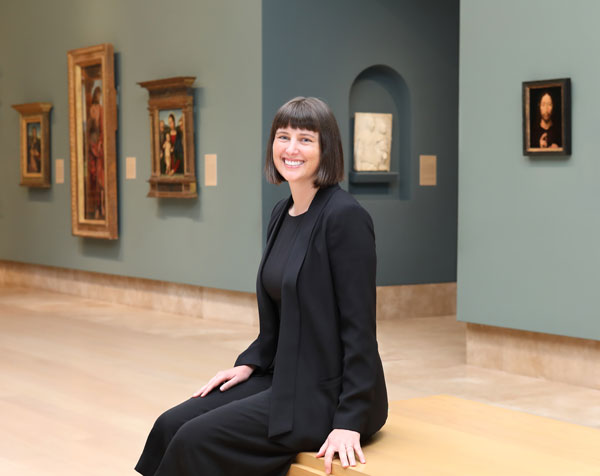An Interview with Maggie Bell, Assistant Curator

Maggie Bell, Assistant Curator
This interview between Chief Curator Emily Talbot and Assistant Curator Maggie Bell first appeared in the Museum’s Fall 2021 Newsletter.
Emily Talbot, Chief Curator: Welcome, Maggie! You’ve been at the Norton Simon Museum for several years now, initially as our Graduate Intern and now as Assistant Curator. Can you describe your art historical training and interests in the field?
Maggie Bell: In college, after enrolling in an art history class on a whim, I was immediately enthralled by questions I had never thought to ask before: How do people represent their world? Who are these representations for? What stories can images tell us about the past, and what do those images mean today? I started to explore related careers through gallery jobs and internships, and I was ultimately drawn to museum work because it combined my interest in art history with community engagement. In graduate school at the University of California, Santa Barbara, I specialized in Italian Renaissance art with a secondary emphasis in the art of colonial Latin America. I sought out ways to further my museum experience, which led to co-curating the exhibition Sacred Art in the Age of Contact: Chumash and Latin American Traditions in Santa Barbara with my colleague Diva Zumaya (now Assistant Curator, LACMA), as part of the Getty’s 2017 initiative Pacific Standard Time: LA/LA. Now, I’m thrilled to be part of the Norton Simon team and to contribute to the research and interpretation of these extraordinary collections.
ET: Your first exhibition at the Norton Simon will be opening this fall, after several COVID-19-related postponements. How did you develop the topic?
MB: I’ve always been interested in how art can affect the body, historically and in the present. I focused on these themes in graduate school, studying the believed healing power of images in 15th-century Italian hospitals. As I came to know the Norton Simon’s collections, I was particularly fascinated by dynamic representations of the human form across diverse mediums. I wondered how these works impacted their original viewers, which led me to develop The Expressive Body as a way of exploring this question directly. Art still moves us today, and my hope is that visitors will not only learn something new about the historical context of these works but also be inspired to consider their own bodily responses to the exhibition.
ET: Has your thinking about the themes of the exhibition changed over the course of our closure?
MB: During the last year, I found myself reimagining the in-person experience of this exhibition. There have been productive discussions in the field about the potential of art museums to not only educate the public but also serve as places for social gathering, rest and contemplation. In this spirit, I’ve included a gallery that will offer guided meditation exercises centered on two paintings, which I hope will encourage visitors to feel present with these works of art in ways that resonate with historical experiences.
I also reconsidered aspects of the exhibition’s interpretive text. I wanted to straightforwardly address the fact that representations of bodies are influenced by social conditions. For instance, the object labels discuss patriarchal attitudes that shaped depictions of women, which is a critical part of understanding how these images were received in the period they were created.
ET: In addition to organizing in-person exhibitions, you’ve been generating content for our website and other digital platforms. Do you find it challenging to translate the experience of art into these virtual formats?
MB: I was delighted to curate Representing Women: Gender and Portraiture in 17th-Century Europe, which will be the Simon’s first digital exhibition. Although some things are lost when experiencing works of art on-screen, I found that an online platform allows for different kinds of exploration that can’t be replicated in galleries. I’m hopeful that this exhibition, which focuses on the lives of 17th-century women, will make this interesting aspect of our collection accessible to a large audience.
ET: What’s next for you? Tell us about some of your forthcoming projects.
MB: In the coming year I’m looking forward to diving into collection-focused research projects. In collaboration with the Museum’s Conservator, John Griswold, I am studying an Italian polychrome, or painted, sculpture of Saint Sebastian to learn more about its materials, origin and function, and it will eventually be the subject of a special exhibition. I will also assist with an upcoming catalogue of the Simon’s early Italian works, which is a project close to my heart because of my doctoral work on 15th-century Sienese painting. And finally, along with my colleagues, I am eager to welcome our incoming Graduate Intern, and I hope to pay forward my own formative experience as an intern at the Simon.
